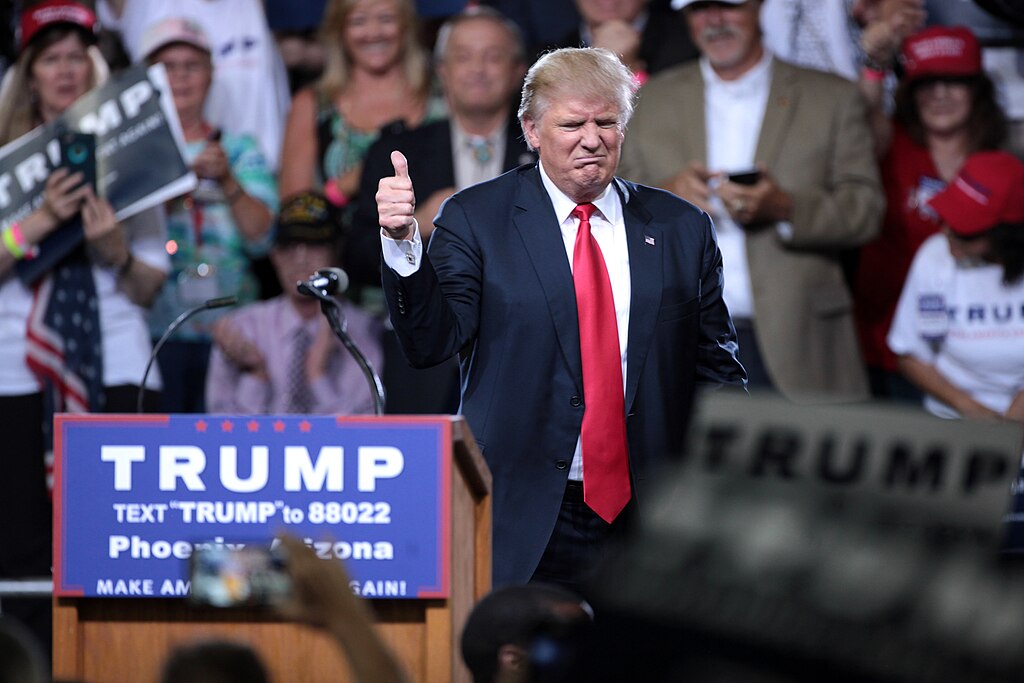Former President Donald Trump is once again under fire, this time for a controversial visit to Arlington National Cemetery that has drawn sharp criticism and raised questions about the conduct of his campaign staff. The visit, intended as a solemn tribute to fallen service members, quickly became a public relations nightmare after reports emerged of a possible altercation between Trump’s staffers and a cemetery official, as well as concerns over the legality of the photo op itself.
Trump, who visited the cemetery on the third anniversary of the Abbey Gate bombing that claimed the lives of several U.S. service members in Afghanistan, was seen posing for photos and videos alongside grieving families. The images, which captured Trump with his characteristic thumbs-up gesture and a wide grin, sparked outrage among critics who questioned the appropriateness of his demeanor in such a solemn setting.
The situation escalated when reports surfaced that two of Trump’s campaign staffers allegedly engaged in a verbal and physical confrontation with an Arlington official who was attempting to enforce federal regulations prohibiting political activities within military cemeteries. According to a spokesperson for the cemetery, a report was filed regarding the incident, though details remain sparse.
In response to the growing criticism, Trump’s campaign spokesman, Stephen Cheung, denied that any physical altercation had occurred, labeling the allegations as defamatory. Cheung asserted that the campaign was prepared to release footage to counter these claims and maintain that Trump and his team conducted themselves with respect and dignity during the visit.
In an effort to quell the backlash, Trump released a statement late Tuesday night from the families of two of the fallen service members, expressing their gratitude for his presence at the gathering. The statement emphasized that Trump and his team were respectful and supportive during the event, which was held in Section 60, the area of Arlington National Cemetery reserved for those who died in recent conflicts.
However, the controversy has not subsided. Critics argue that the presence of campaign videographers and photographers at the gravesites, along with the reported altercation, raises serious ethical and legal concerns. A source familiar with the incident claimed that the cemetery official was simply trying to enforce a federal law that prohibits election-related activities within Army National Military Cemeteries—a regulation that exists to protect the sanctity of these hallowed grounds.
Trump’s campaign, however, insists that the presence of the media was approved by the families involved, who wished to document the occasion. The new statement from the families reiterated their appreciation for Trump’s participation and highlighted his compassion and respect during a difficult time.
As the fallout from the incident continues, the question remains: did Trump’s team cross a line by mixing politics with a solemn act of remembrance? The controversy could have lasting implications for Trump’s campaign as he seeks to navigate the fine line between honoring the military and avoiding the appearance of exploiting such events for political gain.



 Trump Withdraws UN Nominee Stefanik to Preserve GOP Majority in House
Trump Withdraws UN Nominee Stefanik to Preserve GOP Majority in House  Trump Signs Order to Boost Law Enforcement and Concealed Carry Access in D.C.
Trump Signs Order to Boost Law Enforcement and Concealed Carry Access in D.C.  Bernie Sanders Moves to Block $8.8B U.S. Arms Sale to Israel Amid Gaza Crisis
Bernie Sanders Moves to Block $8.8B U.S. Arms Sale to Israel Amid Gaza Crisis  Pam Bondi Calls for Removal of Federal Judges Blocking Trump Policies
Pam Bondi Calls for Removal of Federal Judges Blocking Trump Policies  U.S. Proposes High-Stakes Minerals Deal With Ukraine, Ties Aid to Resource Profits
U.S. Proposes High-Stakes Minerals Deal With Ukraine, Ties Aid to Resource Profits  Trump Organization Plans $1.5B Golf and Real Estate Expansion in Vietnam Amid Tariff Tensions
Trump Organization Plans $1.5B Golf and Real Estate Expansion in Vietnam Amid Tariff Tensions  Putin Proposes Temporary Ukraine Administration to Enable Elections and Peace Talks
Putin Proposes Temporary Ukraine Administration to Enable Elections and Peace Talks  Albanese and Dutton Clash on Healthcare, Economy Ahead of Australian Election
Albanese and Dutton Clash on Healthcare, Economy Ahead of Australian Election  Mexico, U.S. Deepen Migration and Security Ties Amid Rising Trade Tensions
Mexico, U.S. Deepen Migration and Security Ties Amid Rising Trade Tensions  Appeals Court Backs Musk's Cuts to USAID During Legal Battle
Appeals Court Backs Musk's Cuts to USAID During Legal Battle  US Halts WTO Contributions Amid Trump’s Global Spending Review
US Halts WTO Contributions Amid Trump’s Global Spending Review  Judge Blocks Trump-Musk Effort to Shut Down CFPB
Judge Blocks Trump-Musk Effort to Shut Down CFPB  U.S. Reaffirms 'Ironclad' Support for Philippines Amid South China Sea Tensions
U.S. Reaffirms 'Ironclad' Support for Philippines Amid South China Sea Tensions  DOJ Launches Civil Rights Probe into LA Concealed Carry Delays
DOJ Launches Civil Rights Probe into LA Concealed Carry Delays  West Virginia Bans Food Dyes, Moves to Limit Soda Purchases with Food Stamps
West Virginia Bans Food Dyes, Moves to Limit Soda Purchases with Food Stamps  FDA Vaccine Chief Peter Marks Resigns Amid Controversy Over Transparency
FDA Vaccine Chief Peter Marks Resigns Amid Controversy Over Transparency  Panama Grants Safe Passage to Ex-President Martinelli Amid Asylum Move to Nicaragua
Panama Grants Safe Passage to Ex-President Martinelli Amid Asylum Move to Nicaragua 































